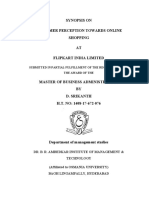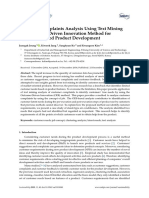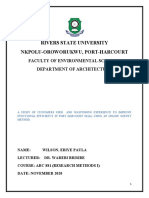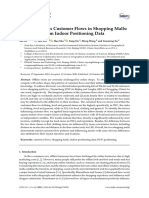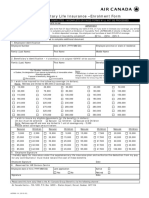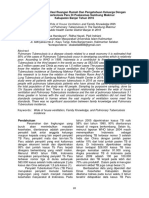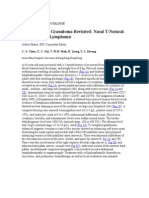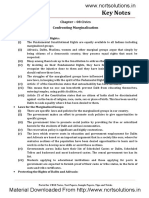Professional Documents
Culture Documents
Post-Occupancy Evaluation (POE) of Shopping Malls in Ota, Ogun State, Nigeria
Copyright
Available Formats
Share this document
Did you find this document useful?
Is this content inappropriate?
Report this DocumentCopyright:
Available Formats
Post-Occupancy Evaluation (POE) of Shopping Malls in Ota, Ogun State, Nigeria
Copyright:
Available Formats
Volume 7, Issue 7, July – 2022 International Journal of Innovative Science and Research Technology
ISSN No:-2456-2165
Post-Occupancy Evaluation (POE) of Shopping Malls
In Ota, Ogun State, Nigeria
SALAMI Adetunji Rasheed1, Ifeoluwa AKANDE2 and Teminijesu Isreal OKE3
College of Environmental Sciences, Department of Architecture, Bells University of Technology, Ota, Ogun State
Abstract:- Shopping center construction projects are building performance to explicitly stated performance
completed more quickly than other types of criteria systematically and rigorously (Aliyu, Muhammad,
construction, as the retail mall owners and developers Mohammed, & Singhry, 2016). In addition, it conveys the
want a quick return on investment as quickly as possible. efficacy of building systems between facility users and
The study focused onthe post-occupancy evaluation of management when applied properly.
shopping malls in Ogun state. Specifically, the study
assessed the physical characteristics of the shopping mall Apart from its use as a performance indicator,
and its environments; examined how well the shopping (Kooymans & Haylock, 2006) suggest that POE is used in
mall matches users’ perception of the adequacy of the determining building defects, formulating design and
spaces within the mall; examined shoppers’ satisfaction construction criteria, supporting performance measures for
with the facilities and services in the study area. With the asset and facility management, lowering facility life cycle
adoption of descriptive statistics (Mean Items Sores, costs by identifying design errors that could lead to
Mean and Standard deviation) as data analysis increased maintenance and operating costs, and clarifying
techniques, the study revealed that the physical design objectives. According to (Cranz, Morhaim, Lindsay,
characteristics of the shopping are in different conditions & Sagan, 2021), post-occupancy evaluation is a research
from architectural perspectives. The study also indicated method that examines how buildings function and
that the shopping malls have adequate spaces for the contributes to both improvements in the building under
shoppers’ movement inside the hall as well as outside the study and general knowledge about how to improve
mall for vehicular movement. Lastly, the findings buildings. Thus, a building should be assessed for
revealed that shoppers are satisfied with the shopping performance after at least six months of occupancy.
mall facilities and services. Thereby, the study concluded
thatthe shopping malls assessed are good conditions in However, due to the attitudes of the owners of the
terms of the physical characteristics of the building, the shopping malls or the knowledge of the builders as well as
available spaces, and the shopper’s perceptions about the architects, the lack of adequate evaluation of the
the facilities and services of the mall. performance of the mall after the completion of the
construction phase might hinder the optimum management
Keywords:- Shopping, Mall, Environment, Post, Occupancy. of built environment facilities of the mall. In some shopping
mall after completion, the available packing space seems not
I. INTRODUCTION to accommodate the customer's cars to the extent that it
results in congestion and increase the customers' waiting
The upsurge of shopping malls is increasingly time. This and many more might affect the customer's
displacing traditional market culture and altering consumer satisfaction and invariably lead to a reduction in patronage.
(shopper) behavior in cities. As a result, shopping center Further, without the utilization of POE, most Architectural
construction projects are completed more quickly than other Engineering and Construction (AEC) experts today rarely
types of construction, as the retail mall owners and monitor the performance of their building post-construction
developers want a quick return on investment as quickly as and there is very little attention to the actual satisfaction of
possible(Niekerk & Cloete, 2020). Also, shopping malls the user (Sedzro, Domea, & Add-Lamptey, 2017).
bring major private capital investment to places where there
was previously little, such as new buildings and significant From the aforementioned, the current study sought to
infrastructural improvements. Comparing the current state of evaluate the condition of shopping malls in Ota, Ogun State,
a structure to its original design intent might provide with attention to the ability of the shopping to meet
valuable information for future design decisions. Because a shoppers' demands. The rest of the study is organized as
building is intrinsically complex, assessing its performance follows; section two presents the methods and materials.
can encompass a wide range of technical, functional, social, While the results are presented in section three, section four
and aesthetic concerns. Assumed the nature of the consists of a discussion, and section five conclude the study.
construction work of the shopping complex in Nigeria, there
is a need for post-occupancy evaluation of such facilities. II. METHODS AND MATERIALS
Post occupancy evaluation (POE) is a tool with which The study employed a survey research design and case
facility managers can identify and evaluate the behavior of a study to evaluate the condition of shopping malls
building (Tookaloo & Smith, 2015). It is also an instrument concerning shoppers' satisfaction. The survey design was
used by experts for the diagnosis of buildings and facilities preferred because of the nature of the study population,
to obtain information useful in the management of the which is, heterogeneous, and spread over a large
building. Thereby, POEs are designed to compare actual geographical area. The design would enable the researcher
IJISRT22JUL1025 www.ijisrt.com 1773
Volume 7, Issue 7, July – 2022 International Journal of Innovative Science and Research Technology
ISSN No:-2456-2165
to collect data that are more primaryand facilitate in-depth adequate; 2 = Dissatisfied/ Inadequate and SD = Strongly
analysis of the study. Likewise, the population of the study dissatisfied/ Grossly inadequate.
consists of the individuals who visit the mall primarily for
shopping and are engaged in shopping. The real population Both descriptive statistics (frequency and simple
of the shoppers appears difficult to obtain since there is no percentage) and Mean Items Score (MIS) were used as data
database for mall shoppers at the moment in Ogun state. In analysis techniques.
such an instance, the researcher adopted the Cochran sample
size formula, which is appropriate for an unknown III. RESULTS
population. Using the formula, the sample was Three A. Questionnaire Response Rate
hundred and Eighty -four (384) and the snowball sampling Out of the 385 questionnaires administered to the
technique was espoused to select the sample size. customers of Justrite Shopping Mall, Ota, Ogun state, 265
A structured questionnaire and observation checklist questionnaires were retrieved. The response rate becomes
(schedule) were used as the research instrument. While a 85% i.e. (265/384* 100 = 69%). Thereby the data analysis
questionnaire was used to solicit information from the was based on 69% of the total administered questionnaires.
shoppers', a checklist was adopted to investigate the B. Characteristics of the Respondents
physical characteristics of the shopping mall in terms of The demographic information of the respondents that is
design and spaces. The statements of the questionnaires considered necessary in the study includes; the gender of the
were framed from the existing literature and relevant respondents, marital status, and age group of the
studies. On the scale basis, the statements of the respondents. The distribution of the data is presented in
questionnaire was on a 4-point Likert scale of the forms; 4 = Table 1 as follows;
Strongly satisfied/ Very adequate, 3 = Satisfied/ Fairly
Demographic Variable Classifications Frequency Percentage
Gender Male 102 38
Female 163 62
Total 265 100
Marital Status Single 172 65
Married 93 35
Total 265 100
Age group 18 - 25years 24 09
26 – 30years 62 23
31 – 35years 51 19
36 – 40years 43 16
41 -45years 36 14
46 – 50years 28 11
Above 50years 21 08
Total 265 100
Table 1: Demographic Characteristics
Source: Researcher’s computation (2022)
Table 1 shows the distribution of demographic 23% of them are within the age group 26 -30 years. Also,
characteristics of the respondents. The gender distribution of 19% of them are within the age group of 31 -35years, and
the respondents indicates that 38% of them were male and 16% of them are within the age group of 36 -40years. While
62% of them were female. By implication, more females 14% of them are within the age group 41 to 45years, 11% of
patronize just rite shopping malls than males. them are within 46 -50 years and 8% of them are 50 years
above.
Further, the marital status distribution of the
respondents revealed that 65% of the respondents are single Physical characteristics of shopping mall and its
and 35% of them are married. This implies that more singles environments.
are patronizing the shopping mall than married. The
outcome might be ascribed to the passion for the singles to Table 2 shows the mean item scores (MIS) of the
hang out or have a feeling of the standard shopping mall like responses and the applicable rankings.
Just rite.
The last demographic characteristic considered was the
age group. The outcome of the variable indicated that 09%
of the respondents are within the age group 18 -25years;
IJISRT22JUL1025 www.ijisrt.com 1774
Volume 7, Issue 7, July – 2022 International Journal of Innovative Science and Research Technology
ISSN No:-2456-2165
Sn Statements N MIS Ranking
1 Design facilities 265 3.60 3rd
2 Mall image 265 4.45 1st
3 Mall decoration 265 3.21 7th
4 Walling material 265 2.34 10th
5 External doors 265 4.10 4th
6 Floor finish 265 3.02 9th
7 Window 265 4.20 2nd
8 Building design 265 3.12 8th
9. Mall ambiance condition 265 3.23 6th
10. Visual comfort (Through artificial lighting and natural lighting) 265 3.42 5th
Table 2: Mean Items Scores (MIS) for physical characteristics of shopping malls
Source: Researcher’s computation (2022)
Table 2. indicates the respective rankings by the
respondent to assess the physical characteristics of the C. Shopping Malls Users’ Perception and Adequacy of the
shopping mall and its environment. From the analysis, the Spaces
mall image was ranked 1st with a mean value of 4.45; The second research objective was to examine how the
followed by the mall window with a mean value of 4.20. shopping mall users’ perceived the adequacy of the spaces
Then, the design facilities of the shopping mall were ranked within the mall. To answer the research questions, the
3rd. The part of the shopping mall that was ranked least researcher adopted mean and standard deviation and the
based on the mean item score is floor finish and walling result is shown in Table 4.4.
material.
Sn Statements Mean Std. Dev
1. Circulation (ease of movement) 3.73 0.47
2. Parking space available 3.36 0.50
3. Space design and allocation 3.68 0.75
4. Wayfinding (finding the shelf) 3.91 0.70
5. Presence of direction signs 3.42 0.61
6. Flow within the mall 3.28 0.72
7. Walkways 4.10 0.82
Grand Mean 3.72 0.46
Table 3: Mean and Standard deviation for Shopping Malls Users’ Perception and Adequacy of the Spaces
Source: Researcher’s computation (2022)
value of 3.72 is greater than 3.5; it can be inferred that the
D. Decision Rule: The mean value < 3.5 = Not adequate; respondents believed that the mall spaces are adequate.
Mean value > 3. 5 = Adequate
Table 3 shows the mean and standard deviation for the E. Shoppers’ satisfaction with the facilities and services
responses on shopping Mall users' perception and adequacy The mean and standard deviation was employed and the
of the Spaces. Using the grand mean, which is 3.72 with a outcome of the analysis is shown in Table 4.
corresponding standard deviation of 0.46. Since the mean
Sn Statements Mean Std. Dev
1 Products quality 3.90 1.06
2 Facility and equipment in the mall 4.60 1.31
3 Price of commodities 3.71 1.24
4. Variety of products 4.14 1.10
5. Number of the automatic teller machine 3.29 1.67
6. Available trolleys 2.34 1.16
7. Conveniently located 3.40 1.59
Grand Mean 3.61 1.30
Table 4: Mean and Standard deviation for Shoppers’ satisfaction with the facilities
Source: Researcher’s computation (2022)
From Table 4 the grand mean for all the statements is cut-off value of 3.5, evidence revealed that the shoppers are
3.62 with a corresponding standard deviation of 1.30. And satisfied with the shopping mall’s facilities and services at
since the rand mean value of 3.61 is greater than the mean the time of the study.
IJISRT22JUL1025 www.ijisrt.com 1775
Volume 7, Issue 7, July – 2022 International Journal of Innovative Science and Research Technology
ISSN No:-2456-2165
IV. DISCUSSION REFERENCES
The discussion section of the study presents an [1.] (Aliyu, Muhammad, Mohammed, & Singhry, 2016)A
interpretation of the findings within the context of the Review of Post-Occupancy Evaluation as A Tool and
literature as well as the field of study, which is architecture. Criteria for Assessing Building Performance.
Three research objectives were formulated and appropriate Conference: Academic Conference on Agenda for
statistical tools were adopted to analyze the data collected Sub-Sahara Africa at University of Abuja, Teaching
from the shopping mall users in the study area. The result of Hospital, Conference Hall, Gwagwalada, Abuja
the first research objective established that the physical FCT-Nigeria Volume: Vol. 4 No. 1
characteristics of the shopping are in different conditions [2.] (Cranz, Morhaim, Lindsay, & Sagan, 2021) Post
from architectural perspectives. As indicated in the study, Occupancy Evaluation in Architectural Education
the “mall image” was ranked first by the users of the and Practice, Technology/Architecture Design, 5:1,
shopping mall. Then followed by the “mall window” and the 25-30
“design facilities” was ranked third. Taking a close look at [3.] (Ishak, Martosenjoyo, Beddu, & Latif, 2020)Post
the shopping mall, the mall image is truly attractive, and the Occupancy Evaluation in the Senate Room, Faculty
type of windows on the wall fits in the form of ventilation of Engineering, Hasanuddin University, Gowa.
required in the shopping mall environment. Thereby, it is Materials Science and Engineering Conference
obvious the shopping mall must have a good image, good Series. 10.1088/1757-899X/875/1/012009
windows for cross-ventilation, and design facilities. Aside [4.] (Kooymans & Haylock, 2006)Post-occupancy
from the types of products available in the mall, the evaluation and workplace productivity. In:
aforementioned architectural elements of a building also Proceedings of the Pacific Rim Real Estate Society
matter. Conference, 22 January 2006. Auckland, New
Zealand, 1-15.
The study also revealed that the spaces in the shopping [5.] (Niekerk & Cloete, 2020). Socio-economic impact
mall are adequate. One of the requirements for a shopping of shopping centers in Gauteng, South Africa. The
mall is adequate spaces both within the mall and outside the Business and Management Review, 11(1), 51 -58
mall. The spaces within a shopping mall include walkways, [6.] (Preiser, Z., & White, 2015). Post-occupancy
for the movement of people from nooks and cranes. In the evaluation, Routledge, NewYork, USA.
same vein, the space outside the mall is also important for [7.] (Tamunoemi & Tamunoemi, 2020)Post Occupancy
car parking and vehicular movement. In the realm of Evaluation: A More Effective Case Study Method.
architecture, the combination of space plays an essential part Global Scientific Journals (GSJ), 8 (1), 1 -10
in the arrangement of the shopping center's internal space, [8.] (Tookaloo & Smith, 2015). International Conference
carries the customer movement path, and is also an on Sustainable Design, Engineering and
important way to plan and connect commercial space. [9.] Construction. Procedia Engineering 118; 515 – 521
Lastly, the findings of the study revealed that the
shoppers are satisfied with the shopping mall facilities and
services. Given the physical characteristics of the shopping
mall, the available spaces, and the varieties of products
among others, pieces of evidence revealed that the shoppers
would be satisfied with the facilities and services.
V. CONCLUSION
The study evaluated the condition of shopping malls in
Ogun state to establish shopper satisfaction. Three
objectives were formulated in line with the aim of the study.
With the use of descriptive statistics (Mean Items Sores,
Mean and Standard deviation) the study revealed that the
physical characteristics of the shopping are in different
conditions from architectural perspectives. The study also
indicated that the shopping malls have adequate spaces for
the shoppers’ movement inside the hall as well as outside
the shopping for vehicular movement. Lastly, the study
indicated that shoppers are satisfied with the shopping mall
facilities and services. Based on the aforementioned, the
study concluded that the condition of the shopping malls
assessed is good conditions in terms of the physical
characteristics of the building, the available spaces, and the
shopper’s perceptions about the facilities and services of the
mall.
IJISRT22JUL1025 www.ijisrt.com 1776
You might also like
- Camille Pissarro Paintings For ReproductionDocument827 pagesCamille Pissarro Paintings For ReproductionPaintingZ100% (1)
- Pressure VesselDocument114 pagesPressure Vesseldanemsal100% (3)
- Parts of A Concept PaperDocument29 pagesParts of A Concept PaperArianne SagumNo ratings yet
- RCOG Guidelines - Gestational Trophoblastic DiseaseDocument12 pagesRCOG Guidelines - Gestational Trophoblastic Diseasemob3100% (1)
- A 732 - A732M - 02 Equivalencia Ic AstmDocument8 pagesA 732 - A732M - 02 Equivalencia Ic AstmorivaldopenaNo ratings yet
- Organization Development: Developing the Processes and Resources for High-Tech BusinessesFrom EverandOrganization Development: Developing the Processes and Resources for High-Tech BusinessesNo ratings yet
- The Research Concept PaperDocument4 pagesThe Research Concept PaperAngelica BelardoNo ratings yet
- CALIMOVEDocument46 pagesCALIMOVERasheedAladdinNGuiomala0% (1)
- Delhi-HC-Cruelty by WifeDocument19 pagesDelhi-HC-Cruelty by WifeSachin BansalNo ratings yet
- Site Visit ReportDocument7 pagesSite Visit ReportAhmad0% (1)
- GOVT - Departments - Contact - Details - MF-14-06-2021 UpdatedDocument32 pagesGOVT - Departments - Contact - Details - MF-14-06-2021 Updatedadf_raghuNo ratings yet
- The Practice of Yoga and Its Philosophy FinalDocument23 pagesThe Practice of Yoga and Its Philosophy Finalshwets91No ratings yet
- Procurement and Supply in Projects: Misunderstood and Under ResearchedFrom EverandProcurement and Supply in Projects: Misunderstood and Under ResearchedRating: 5 out of 5 stars5/5 (1)
- Customer Perception Towards Online Shopping at Flipkart PDFDocument11 pagesCustomer Perception Towards Online Shopping at Flipkart PDFSrikanth Chanda100% (2)
- Studying The Consumer Buying Behavior While Buying A LaptopDocument47 pagesStudying The Consumer Buying Behavior While Buying A LaptopTushar Alva83% (12)
- Customer Satisfaction in Online Shopping SupuDocument7 pagesCustomer Satisfaction in Online Shopping SupuSawan AcharyNo ratings yet
- Questionnaire Designing For A Survey On Reason For Product Return and Reverse Logistics Performance On Customer Satisfaction in Online ShoppingDocument5 pagesQuestionnaire Designing For A Survey On Reason For Product Return and Reverse Logistics Performance On Customer Satisfaction in Online ShoppingGajendra NayagamNo ratings yet
- 123838388383ser. Mater. Sci. Eng. 801 012146Document10 pages123838388383ser. Mater. Sci. Eng. 801 012146Hazel ZabellaNo ratings yet
- Research MethodologyDocument4 pagesResearch MethodologyVikasMishraNo ratings yet
- Synopsis Store Layout (WWW - Writekraft.com)Document11 pagesSynopsis Store Layout (WWW - Writekraft.com)Vikas KhannaNo ratings yet
- Efficacy, Reliability, and Accuracy of Inventory System and Point-of-Sale Service For Small-Medium Enterprises in Tabuk CityDocument6 pagesEfficacy, Reliability, and Accuracy of Inventory System and Point-of-Sale Service For Small-Medium Enterprises in Tabuk CityIJELS Research JournalNo ratings yet
- FINALDocument20 pagesFINALSivapathi NANo ratings yet
- Logistic in Online ShoppingDocument108 pagesLogistic in Online ShoppingSuhail FaridNo ratings yet
- Measuring Consumer Perceptions of Online Shopping ConvenienceDocument25 pagesMeasuring Consumer Perceptions of Online Shopping ConvenienceJustine Hope RamosNo ratings yet
- Department Store ThesisDocument7 pagesDepartment Store Thesisafcmrdbef100% (2)
- Customer RegretDocument15 pagesCustomer RegretAmbreen ZahraNo ratings yet
- Research Methodology To InputDocument13 pagesResearch Methodology To InputBhaskar GarimellaNo ratings yet
- Sustainability 11 00040Document14 pagesSustainability 11 00040Jesus AlarconNo ratings yet
- PublishedpaperDocument5 pagesPublishedpaperMohassan SalebanNo ratings yet
- Cib DC26936Document12 pagesCib DC26936arch otoomNo ratings yet
- Build Online Shop HtmlDocument10 pagesBuild Online Shop HtmlReagan LuckyNo ratings yet
- Method For Ranking Online ReviewsDocument50 pagesMethod For Ranking Online Reviewskavya J.CNo ratings yet
- Ebi Assignment ResearchDocument23 pagesEbi Assignment ResearchEBIYE WILSONNo ratings yet
- Interim ReportDocument13 pagesInterim ReportDeepanshi RawatNo ratings yet
- Kuwait Mall The - Importance - of - Distance - andDocument18 pagesKuwait Mall The - Importance - of - Distance - andpoNo ratings yet
- A Study On Customer Satisfaction Towards Fastrack Watches With Reference of Coimbatore CityDocument5 pagesA Study On Customer Satisfaction Towards Fastrack Watches With Reference of Coimbatore CityMathavan VNo ratings yet
- Aurora Customer Satisfaction-Tata MotorsDocument14 pagesAurora Customer Satisfaction-Tata MotorswebstdsnrNo ratings yet
- Sensors 20 03291 v3Document22 pagesSensors 20 03291 v3xiaoshuidiqqNo ratings yet
- Construction Literature ReviewDocument7 pagesConstruction Literature Reviewc5e4jfpn100% (1)
- Chapter-VIII Limitations of The Study and Future Research DirectionsDocument5 pagesChapter-VIII Limitations of The Study and Future Research DirectionsAkinbode Sunday OluwagbengaNo ratings yet
- Review Jurnal CB 2 (Sciencefirect Q1)Document16 pagesReview Jurnal CB 2 (Sciencefirect Q1)coffecake24No ratings yet
- Meta-Analysis For Online Retail Performance: Ankur Kapoor Dheeraj Sharma W.P. No. 2016-03-45Document18 pagesMeta-Analysis For Online Retail Performance: Ankur Kapoor Dheeraj Sharma W.P. No. 2016-03-45seemaNo ratings yet
- Solution To Q2Document19 pagesSolution To Q2apurv43No ratings yet
- KTM Full ProjectDocument60 pagesKTM Full ProjectdivyashreebcomcsNo ratings yet
- A Study On The Facility Layout and Design of Sugar Plants in The PhilippinesDocument11 pagesA Study On The Facility Layout and Design of Sugar Plants in The PhilippinesKim EstrellaNo ratings yet
- A Report On E-BusinessDocument65 pagesA Report On E-Businesssmartway projectsNo ratings yet
- A study on consumer awareness and satisfaction towards IRCTCDocument8 pagesA study on consumer awareness and satisfaction towards IRCTCSarit SinghNo ratings yet
- alekya-PERFORMANACE OF MUTYAL FUNDSDocument15 pagesalekya-PERFORMANACE OF MUTYAL FUNDSwebstdsnrNo ratings yet
- Shopping Mall Research PaperDocument5 pagesShopping Mall Research Papergvzfmq91100% (1)
- Technical Proposal Market SurveyDocument14 pagesTechnical Proposal Market SurveylealemNo ratings yet
- Research Papper 01Document9 pagesResearch Papper 01Ishaan GuptaNo ratings yet
- New Final PDFDocument55 pagesNew Final PDFtejaNo ratings yet
- Analyzing Consensus Via Making Multicriteria Decision Analysis MethodologyDocument12 pagesAnalyzing Consensus Via Making Multicriteria Decision Analysis MethodologyIJRASETPublicationsNo ratings yet
- Customers Attitutes Towards Technology Based Services, BanksDocument13 pagesCustomers Attitutes Towards Technology Based Services, BanksHemishta BundhooNo ratings yet
- A Research Project On: "To Study The Consumer Behavior Towards Online Shopping"Document21 pagesA Research Project On: "To Study The Consumer Behavior Towards Online Shopping"MANOJ Jaipuria-JaipurNo ratings yet
- A Study On Customer Satisfaction Towards The Services of Canara Bank With Special Reference To Tirupur CityDocument14 pagesA Study On Customer Satisfaction Towards The Services of Canara Bank With Special Reference To Tirupur CitySandhya DnNo ratings yet
- Online Survay of Online ShoppingDocument7 pagesOnline Survay of Online Shoppingusama ahmadNo ratings yet
- Accessing The Effectiveness of Online Shopping Among Malaysian ConsumersDocument11 pagesAccessing The Effectiveness of Online Shopping Among Malaysian ConsumersToheebdareNo ratings yet
- 8 Yunita 076 Sophroth 070 Louguid Zahra 008Document5 pages8 Yunita 076 Sophroth 070 Louguid Zahra 008umaraccaNo ratings yet
- Building Predictive Models For Market Research Using Machine LearningDocument8 pagesBuilding Predictive Models For Market Research Using Machine LearningIJRASETPublicationsNo ratings yet
- MRP 2 VCDocument7 pagesMRP 2 VCVinita OzaNo ratings yet
- CHAPTERDocument62 pagesCHAPTERdhrishyaNo ratings yet
- 1281 2558 1 SMDocument18 pages1281 2558 1 SMBAYU KHARISMANo ratings yet
- Chatterjee 2020Document13 pagesChatterjee 2020Mai NguyenNo ratings yet
- EVANGELISTADocument22 pagesEVANGELISTAHale AdrianoNo ratings yet
- Project Report: Submitted in Partial Fulfillment of The Degree of Masters of Business Administration Session (2016-2017)Document69 pagesProject Report: Submitted in Partial Fulfillment of The Degree of Masters of Business Administration Session (2016-2017)Shahrukh Khan100% (1)
- The Shopping List in Goal-Directed Shopping: Scale Development and ValidationDocument25 pagesThe Shopping List in Goal-Directed Shopping: Scale Development and ValidationPhuoc NguyenNo ratings yet
- Ijarcce 2023 124187Document5 pagesIjarcce 2023 124187JonathanNo ratings yet
- What Influences Customer Flows in Shopping Malls: Perspective From Indoor Positioning DataDocument19 pagesWhat Influences Customer Flows in Shopping Malls: Perspective From Indoor Positioning DataClarissa LacernaNo ratings yet
- An Analysis on Mental Health Issues among IndividualsDocument6 pagesAn Analysis on Mental Health Issues among IndividualsInternational Journal of Innovative Science and Research TechnologyNo ratings yet
- Harnessing Open Innovation for Translating Global Languages into Indian LanuagesDocument7 pagesHarnessing Open Innovation for Translating Global Languages into Indian LanuagesInternational Journal of Innovative Science and Research TechnologyNo ratings yet
- Diabetic Retinopathy Stage Detection Using CNN and Inception V3Document9 pagesDiabetic Retinopathy Stage Detection Using CNN and Inception V3International Journal of Innovative Science and Research TechnologyNo ratings yet
- Investigating Factors Influencing Employee Absenteeism: A Case Study of Secondary Schools in MuscatDocument16 pagesInvestigating Factors Influencing Employee Absenteeism: A Case Study of Secondary Schools in MuscatInternational Journal of Innovative Science and Research TechnologyNo ratings yet
- Exploring the Molecular Docking Interactions between the Polyherbal Formulation Ibadhychooranam and Human Aldose Reductase Enzyme as a Novel Approach for Investigating its Potential Efficacy in Management of CataractDocument7 pagesExploring the Molecular Docking Interactions between the Polyherbal Formulation Ibadhychooranam and Human Aldose Reductase Enzyme as a Novel Approach for Investigating its Potential Efficacy in Management of CataractInternational Journal of Innovative Science and Research TechnologyNo ratings yet
- The Making of Object Recognition Eyeglasses for the Visually Impaired using Image AIDocument6 pagesThe Making of Object Recognition Eyeglasses for the Visually Impaired using Image AIInternational Journal of Innovative Science and Research TechnologyNo ratings yet
- The Relationship between Teacher Reflective Practice and Students Engagement in the Public Elementary SchoolDocument31 pagesThe Relationship between Teacher Reflective Practice and Students Engagement in the Public Elementary SchoolInternational Journal of Innovative Science and Research TechnologyNo ratings yet
- Dense Wavelength Division Multiplexing (DWDM) in IT Networks: A Leap Beyond Synchronous Digital Hierarchy (SDH)Document2 pagesDense Wavelength Division Multiplexing (DWDM) in IT Networks: A Leap Beyond Synchronous Digital Hierarchy (SDH)International Journal of Innovative Science and Research TechnologyNo ratings yet
- Comparatively Design and Analyze Elevated Rectangular Water Reservoir with and without Bracing for Different Stagging HeightDocument4 pagesComparatively Design and Analyze Elevated Rectangular Water Reservoir with and without Bracing for Different Stagging HeightInternational Journal of Innovative Science and Research TechnologyNo ratings yet
- The Impact of Digital Marketing Dimensions on Customer SatisfactionDocument6 pagesThe Impact of Digital Marketing Dimensions on Customer SatisfactionInternational Journal of Innovative Science and Research TechnologyNo ratings yet
- Electro-Optics Properties of Intact Cocoa Beans based on Near Infrared TechnologyDocument7 pagesElectro-Optics Properties of Intact Cocoa Beans based on Near Infrared TechnologyInternational Journal of Innovative Science and Research TechnologyNo ratings yet
- Formulation and Evaluation of Poly Herbal Body ScrubDocument6 pagesFormulation and Evaluation of Poly Herbal Body ScrubInternational Journal of Innovative Science and Research TechnologyNo ratings yet
- Advancing Healthcare Predictions: Harnessing Machine Learning for Accurate Health Index PrognosisDocument8 pagesAdvancing Healthcare Predictions: Harnessing Machine Learning for Accurate Health Index PrognosisInternational Journal of Innovative Science and Research TechnologyNo ratings yet
- The Utilization of Date Palm (Phoenix dactylifera) Leaf Fiber as a Main Component in Making an Improvised Water FilterDocument11 pagesThe Utilization of Date Palm (Phoenix dactylifera) Leaf Fiber as a Main Component in Making an Improvised Water FilterInternational Journal of Innovative Science and Research TechnologyNo ratings yet
- Cyberbullying: Legal and Ethical Implications, Challenges and Opportunities for Policy DevelopmentDocument7 pagesCyberbullying: Legal and Ethical Implications, Challenges and Opportunities for Policy DevelopmentInternational Journal of Innovative Science and Research TechnologyNo ratings yet
- Auto Encoder Driven Hybrid Pipelines for Image Deblurring using NAFNETDocument6 pagesAuto Encoder Driven Hybrid Pipelines for Image Deblurring using NAFNETInternational Journal of Innovative Science and Research TechnologyNo ratings yet
- Terracing as an Old-Style Scheme of Soil Water Preservation in Djingliya-Mandara Mountains- CameroonDocument14 pagesTerracing as an Old-Style Scheme of Soil Water Preservation in Djingliya-Mandara Mountains- CameroonInternational Journal of Innovative Science and Research TechnologyNo ratings yet
- A Survey of the Plastic Waste used in Paving BlocksDocument4 pagesA Survey of the Plastic Waste used in Paving BlocksInternational Journal of Innovative Science and Research TechnologyNo ratings yet
- Hepatic Portovenous Gas in a Young MaleDocument2 pagesHepatic Portovenous Gas in a Young MaleInternational Journal of Innovative Science and Research TechnologyNo ratings yet
- Design, Development and Evaluation of Methi-Shikakai Herbal ShampooDocument8 pagesDesign, Development and Evaluation of Methi-Shikakai Herbal ShampooInternational Journal of Innovative Science and Research Technology100% (3)
- Explorning the Role of Machine Learning in Enhancing Cloud SecurityDocument5 pagesExplorning the Role of Machine Learning in Enhancing Cloud SecurityInternational Journal of Innovative Science and Research TechnologyNo ratings yet
- A Review: Pink Eye Outbreak in IndiaDocument3 pagesA Review: Pink Eye Outbreak in IndiaInternational Journal of Innovative Science and Research TechnologyNo ratings yet
- Automatic Power Factor ControllerDocument4 pagesAutomatic Power Factor ControllerInternational Journal of Innovative Science and Research TechnologyNo ratings yet
- Review of Biomechanics in Footwear Design and Development: An Exploration of Key Concepts and InnovationsDocument5 pagesReview of Biomechanics in Footwear Design and Development: An Exploration of Key Concepts and InnovationsInternational Journal of Innovative Science and Research TechnologyNo ratings yet
- Mobile Distractions among Adolescents: Impact on Learning in the Aftermath of COVID-19 in IndiaDocument2 pagesMobile Distractions among Adolescents: Impact on Learning in the Aftermath of COVID-19 in IndiaInternational Journal of Innovative Science and Research TechnologyNo ratings yet
- Studying the Situation and Proposing Some Basic Solutions to Improve Psychological Harmony Between Managerial Staff and Students of Medical Universities in Hanoi AreaDocument5 pagesStudying the Situation and Proposing Some Basic Solutions to Improve Psychological Harmony Between Managerial Staff and Students of Medical Universities in Hanoi AreaInternational Journal of Innovative Science and Research TechnologyNo ratings yet
- Navigating Digitalization: AHP Insights for SMEs' Strategic TransformationDocument11 pagesNavigating Digitalization: AHP Insights for SMEs' Strategic TransformationInternational Journal of Innovative Science and Research Technology100% (1)
- Drug Dosage Control System Using Reinforcement LearningDocument8 pagesDrug Dosage Control System Using Reinforcement LearningInternational Journal of Innovative Science and Research TechnologyNo ratings yet
- The Effect of Time Variables as Predictors of Senior Secondary School Students' Mathematical Performance Department of Mathematics Education Freetown PolytechnicDocument7 pagesThe Effect of Time Variables as Predictors of Senior Secondary School Students' Mathematical Performance Department of Mathematics Education Freetown PolytechnicInternational Journal of Innovative Science and Research TechnologyNo ratings yet
- Formation of New Technology in Automated Highway System in Peripheral HighwayDocument6 pagesFormation of New Technology in Automated Highway System in Peripheral HighwayInternational Journal of Innovative Science and Research TechnologyNo ratings yet
- Booklet - EpfpclDocument9 pagesBooklet - EpfpclAnonymous G5Od0CTrmeNo ratings yet
- Analysis of A Healthcare Risk Management PlanDocument6 pagesAnalysis of A Healthcare Risk Management PlanGeralds B GeraldNo ratings yet
- Đề Ôn Thi Tuyển Sinh Lớp 6 Môn Tiếng AnhDocument7 pagesĐề Ôn Thi Tuyển Sinh Lớp 6 Môn Tiếng AnhHoa TrònNo ratings yet
- Hvac Ducting System - BoqDocument6 pagesHvac Ducting System - BoqBeò FhathastNo ratings yet
- DD Cen TS 15534-3-2007Document14 pagesDD Cen TS 15534-3-2007MladenMarkovicNo ratings yet
- Supplementary Life Insurance - Enrolment FormDocument1 pageSupplementary Life Insurance - Enrolment FormjeevaNo ratings yet
- Relationship Wide of House VentilationDocument5 pagesRelationship Wide of House VentilationNova RizkenNo ratings yet
- Human Heredity Principles and Issues 10th Edition Michael Cummings Solutions Manual 1Document10 pagesHuman Heredity Principles and Issues 10th Edition Michael Cummings Solutions Manual 1yvette100% (39)
- Hardees ReviewDocument17 pagesHardees ReviewFarhan KamalNo ratings yet
- Journal No. 3 "Specialized Leaves"Document10 pagesJournal No. 3 "Specialized Leaves"Ej AgsaldaNo ratings yet
- Topic 3.3 - Energy Systems: 3.3.1 Draw A Diagram To Show The Ultrastructure of A Generalized Animal CellDocument8 pagesTopic 3.3 - Energy Systems: 3.3.1 Draw A Diagram To Show The Ultrastructure of A Generalized Animal CellTiago José ReisNo ratings yet
- Diagnosis in OncologyDocument22 pagesDiagnosis in OncologyAndi SuryajayaNo ratings yet
- Dr. P S Adhya 7186Document1 pageDr. P S Adhya 7186Partha AdhyaNo ratings yet
- Chapter - 08 Civics Confronting Marginalisation: Invoking Fundamental RightsDocument2 pagesChapter - 08 Civics Confronting Marginalisation: Invoking Fundamental Rightsnbs saraswathiNo ratings yet
- Soft Skills in The Pharmacy Curriculum: Lilian M. AzzopardiDocument14 pagesSoft Skills in The Pharmacy Curriculum: Lilian M. Azzopardishailendra patilNo ratings yet
- EER WorksheetDocument3 pagesEER WorksheetMichael PoddubnyNo ratings yet
- GPAT Pharmaceutical Chemistry SyllabusDocument4 pagesGPAT Pharmaceutical Chemistry Syllabuskumar HarshNo ratings yet
- GFT 4 Rail Installation Guide 20171219 1Document31 pagesGFT 4 Rail Installation Guide 20171219 1Comsip400No ratings yet
- Fmea - Failure Mode Effect AnalysisDocument23 pagesFmea - Failure Mode Effect AnalysisAsawari JoshiNo ratings yet
- Pharmacy CUM L IIIDocument78 pagesPharmacy CUM L IIIashagrie100% (1)
- Hydraulic Fluids in Mobile Application Re98128 - 2015-06 - Online PDFDocument13 pagesHydraulic Fluids in Mobile Application Re98128 - 2015-06 - Online PDFDennis Huanuco CcamaNo ratings yet













